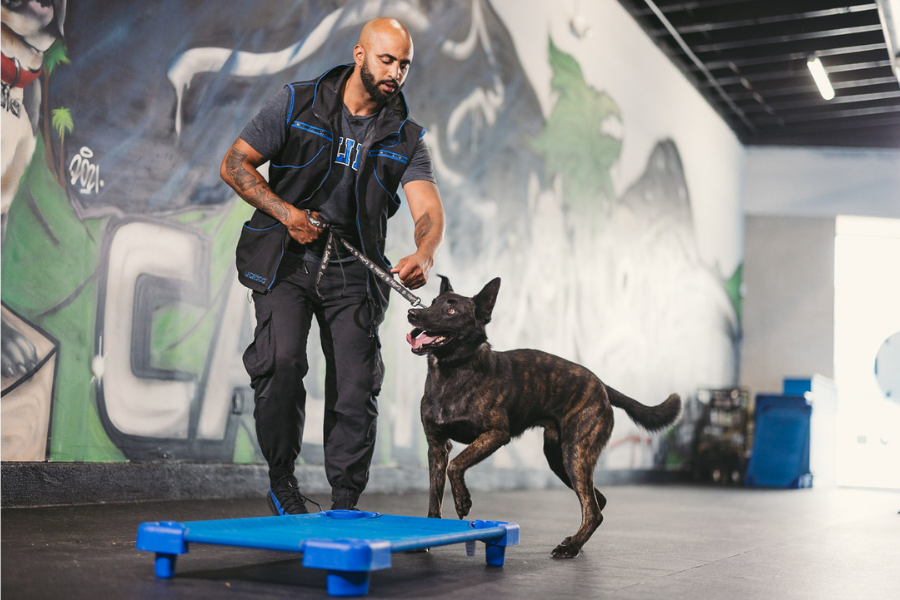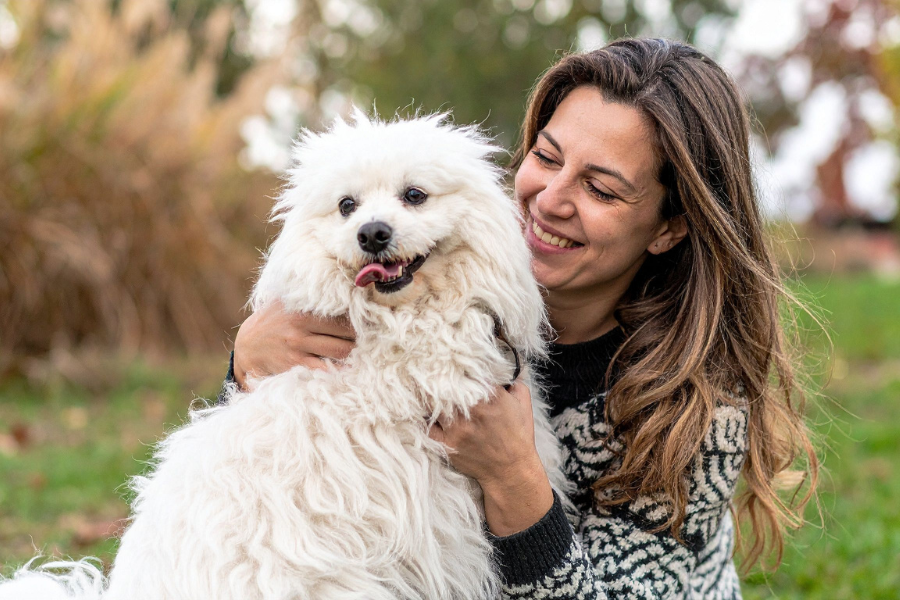
How to Train Your Dog to Become a Service Dog
- Published on:
- By: ASP Team
Service dogs play a vital role in assisting individuals with disabilities—both visible and invisible.
Whether helping with mobility, guiding the visually impaired, or mitigating psychiatric symptoms like anxiety or PTSD, these dogs are trained to perform specific tasks that enable greater independence.
If you’re wondering how to make your dog your service dog, either for yourself or someone you care for, this guide covers everything you need to know—from legal qualifications to effective training methods, including how iTrain Academy by American Service Pets can support your journey.
What is a Service Dog?
Under the Americans with Disabilities Act (ADA), a service dog is defined as a dog individually trained to perform tasks or work for a person with a disability.
These disabilities can be physical, such as mobility impairments, or psychiatric, including conditions like anxiety, PTSD, or bipolar disorder. Service dogs play a crucial role in assisting their handlers and improving their quality of life.
You may be wondering how to make your dog your service dog. To qualify as a service animal under the ADA, a dog must be trained to perform specific tasks directly related to the handler’s disability.
Additionally, the dog must behave appropriately in public settings and remain under control at all times, whether through a leash, harness, or verbal commands.
Who Can Train a Service Dog?
Did you know you don’t need to be a professional trainer to train your own service dog? According to ADA guidelines, anyone can train their service dog themselves—no certification required!
That said, your dog’s training must meet top-notch standards in reliability, obedience, and task performance to ensure they’re fully equipped to assist you in your daily life.
Some people choose to train a dog they already own or adopt a pup with the right temperament for service work. Others prefer a more hands-on approach with a structured program like iTrain Academy, which offers expert guidance every step of the way.
However you decide to approach it, investing time and effort in proper training is the key to creating a loyal, capable, and dependable service dog.
Get Your ESA Today
How to Make Your Dog Your Service Dog
Step 1: Determine Eligibility
Before beginning training, make sure you meet the ADA definition of a person with a disability. Your condition must substantially limit one or more major life activities.
Common qualifying conditions include:
- Mobility limitations
- Vision or hearing loss
- Seizure disorders
- Diabetes (for alerting to blood sugar changes)
- Psychiatric conditions like PTSD, anxiety, or severe depression
To formalize your service dog relationship, you may choose to obtain a Psychiatric Service Animal (PSA) letter through a licensed mental health provider—available here.
Step 2: Choose the Right Dog
Not all dogs are suitable for service work. Ideally, a good service dog candidate will be:
- Calm and confident
- Intelligent and responsive to training
- Non-reactive to distractions
- Healthy and of suitable size for physical tasks (if needed)
Popular service breeds include:
- Labrador Retrievers
- Golden Retrievers
- Poodles
- German Shepherds
- Border Collies
However, breed doesn’t matter as much as temperament and trainability.
Step 3: Begin Foundational Obedience Training
Before a dog can perform advanced tasks, they need to master basic obedience. This includes:
- Sit, stay, down, come
- Heel (walking calmly beside handler)
- Leave it (ignore distractions)
- Focus/watch me (maintain attention)
A dog must be reliable in both quiet and busy environments. Training in multiple locations (home, parks, stores) is key.
Tip: The iTrain Academy program provides structured video lessons that guide you through obedience and advanced task training, with as little as 15 minutes a day.
Step 4: Train Task-Specific Skills
Once your dog has mastered obedience skills, you can begin training them to perform tasks that directly assist with your disability. For individuals with visual impairments, this might include guiding safely through environments.
Those with mobility challenges may benefit from a dog trained to retrieve items, while psychiatric service dogs can be taught to interrupt anxiety attacks or flashbacks.
Additionally, dogs can be trained to notify handlers of medical alerts, such as low blood sugar or seizures, or to apply deep pressure therapy during panic episodes.
It is essential that each task is clearly linked to your specific condition. Consistency and reliability in their behavior will ensure your dog can effectively assist in public spaces.
Step 5: Prepare for Public Access
A well-behaved dog is essential in all public environments to ensure safety and harmony.
This includes the ability to walk calmly through crowded areas, ignore distractions such as food on the floor or loud noises, and refrain from barking or seeking attention from others. Additionally, the dog must remain under control at all times, whether on a leash or responding to voice commands.
While a public access test is not legally required, many training programs, including iTrain Academy, follow these standards to ensure dogs are adequately prepared for public settings.
These simulations equip dogs with the necessary behavior and obedience skills to handle various situations with professionalism and reliability.
Step 6: Understand Your Legal Rights
Once your dog is task-trained and behaves appropriately in public, they are considered a legal service animal under ADA law. This gives you the right to bring your dog into:
- Restaurants and stores
- Public transportation
- Airports and airplanes
- Workplaces (with reasonable accommodations)
- Rental housing (even in no-pet buildings)
Note: Business owners can only ask two questions:
- Is the dog required because of a disability?
- What task has the dog been trained to perform?
They cannot request documentation, ID cards, or vests. However, many handlers choose to carry a PSA letter and training documentation for smoother interactions.
How iTrain Academy Can Help You Train Your Service Dog
At American Service Pets, we understand that not everyone has access to local service dog trainers or thousands to spend on certified programs. That’s why we developed iTrain Academy, a fully online dog training program tailored for service dog preparation.
With iTrain, you’ll learn to:
- Teach basic and advanced obedience
- Introduce task-based commands specific to your condition
- Prepare your dog for public access behavior
- Practice consistency and confidence as a handler
The training is:
- 100% online
- Designed by certified trainers
- Suitable for all breeds and ages
- Broken into bite-sized, daily lessons (15 minutes a day)
Whether you’re starting from scratch or transitioning an emotional support animal into a task-trained service dog, iTrain gives you the tools and confidence to succeed.
Tips for Training a Service Dog
Training a service dog is a demanding but highly rewarding process. It requires patience, commitment, and consistency to equip your dog with the essential skills and behaviors. Below are some key tips to help you effectively train your service dog:
- Begin early: Starting training at a young age is ideal. Puppies are more adaptable and tend to learn new skills more quickly than adult dogs.
- Maintain consistency: Consistency is critical in any training process. Use the same commands and reward system consistently to reinforce desired behaviors.
- Implement positive reinforcement: Positive reinforcement is one of the most effective training techniques. Reward good behavior with treats, praise, and affection to encourage your dog to repeat those actions.
- Understand your dog’s individual needs: Every dog is unique, with its own motivations and requirements. Take the time to understand these factors and tailor your training methods accordingly.
- Consult a professional if needed: If you encounter difficulties or feel additional guidance would be beneficial, seek assistance from a professional trainer or behaviorist.
By following these guidelines, you can help set your service dog up for success in their vital role.
FAQs
Do I need professional certification to make my dog a service dog?
No. Under the ADA, professional certification is not required. You can train your own dog as long as they are taught specific tasks related to your disability and behave properly in public. Training standards must be high, but certification or registration is not legally necessary.
How long does it take to train a service dog?
Training time varies depending on the dog’s age, temperament, and the complexity of tasks. On average, it can take 6 to 18 months to fully train a service dog. Programs like iTrain Academy can help you pace the process with daily lessons.
Can any breed become a service dog?
Potentially, yes. While breeds like Labradors, Golden Retrievers, and Poodles are popular, any breed that is intelligent, calm, and trainable can qualify. The most important factors are temperament, behavior, and task-specific ability—not breed alone.
Conclusion
Training your own service dog is a serious—but achievable—commitment. With patience, consistency, and a solid plan, you can create a powerful bond and a working partnership that enhances your quality of life.
Remember:
- Not every dog will qualify—but many can with the right support
- Task training is what legally defines a service dog
- Online programs like iTrain Academy offer flexibility, affordability, and structure
- Your service dog can become a key part of managing your disability and gaining independence
At American Service Pets, we’re here to support your journey every step of the way.

The benefits of an Emotional Support Animal certification and a Psychiatric Service Dog certification are drastically different. Fortunately for you, American Service Pets’ network of active board certified doctor or other licensed mental health providers can help you find the right path to certification. To find out whether you need an ESA or PSD letter, take our easy, three-step Pet Owner Survey!
More Great Resources





